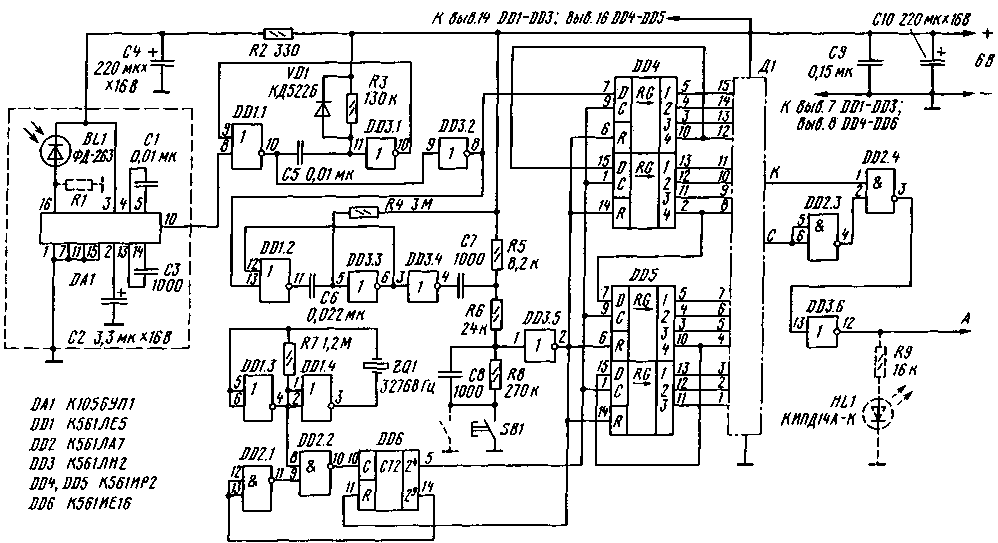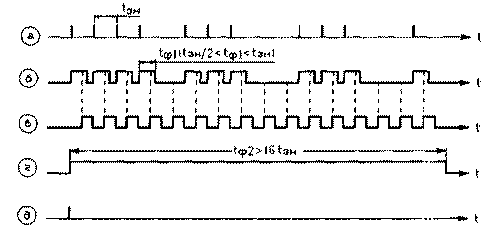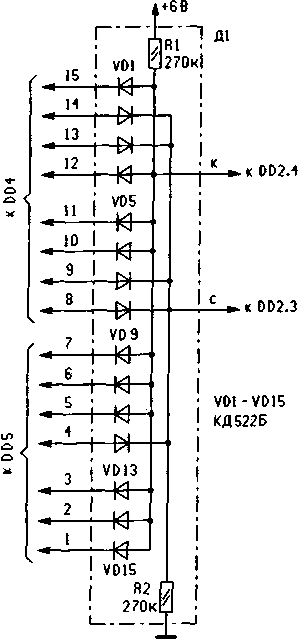
|
|
ENCYCLOPEDIA OF RADIO ELECTRONICS AND ELECTRICAL ENGINEERING Electronic password. Encyclopedia of radio electronics and electrical engineering
Encyclopedia of radio electronics and electrical engineering / Digital technology In this part of the article, its author talks about the principle of operation and design of the IR receiver, which, together with the key fob generator, constitutes an automatic identification system for "friends". A diagram of a device that receives a coded signal from an infrared emitter is shown in fig. 1. The DA1 microcircuit, which is a photoamplifier, converts current pulses in the BL1 photodiode, excited by IR flashes of the key fob emitter, into voltage pulses suitable for their direct injection into a digital analyzer. On fig. 2a shows a graph of the pulse sequence at the output of the photoamplifier, corresponding to the code 111011100111001, which we will consider here and below as an example. The receiver has two generators. One of them, made on the elements DD1.1 and DD3.1, expands each of the input pulses (recall, the duration of the IR transmitter pulses is about 10 μs) to tf1=RЗС5=0,6...0,8 ms (Fig. 2,6). And the second, assembled on the elements DD1.2 and DD3.3, forms a pulse with a duration tf2=R4C6=30...50 ms (Fig. 2d). On the 1st edge of this pulse, a short pulse (tr=R3.5C5=7 μs) is formed at the output of the DD10 element, setting the shift register DD4DD5 and the counter DD6 to zero (Fig. 2,e). Elements DD1.3, DD1.4, resistor R7 and quartz resonator ZQ1 form a master oscillator operating at a frequency of 32 Hz (we recall that the master oscillator of the IR emitter also operates at the same frequency).
In the shift register, the received signal (or interference) is fixed as follows. On the edge of the pulse of the first IR flash, the DD4-DD6 microcircuits are set to the zero state (zeros appear at their outputs) and the DD6 counter starts counting pulses with a frequency of 32 Hz. After about 768 ms (tzn / 0,5), zero at output 2 (pin 24) of counter DD5 will be replaced by one. In the shift register K6IR561, such a voltage drop at input C leads to the displacement of the number stored in it by one digit towards the older ones (according to the diagram in Fig. 2 - down), and the value that at that moment will be entered into the lower digit of the DD1 microcircuit at its input D (pin 4). It can be 7 - extended to tf1 "single" pulse, and 1 - if there was no flash in this familiarity of the code message. The next shift of the number will occur in tzn=0 ms - a "step", which will be preserved in the future. The system will make only 16 bit shifts (shift pulses generated by the counter DD6 are illustrated in Fig. 2, c) - with the appearance of a high level signal (log. 1) at the output 29 of the counter DD6 and, accordingly, low (log. 0) at the input DD2.2 (pin 9), the counter will lock itself and keep this state until the next system start. Thus, the received sequence of IR flashes is converted into a number stored in register DD4DD5. It remains to be seen whether it is code. This is carried out by a diode-resistor decoder D1, the circuit of which (for the same code 111011100111001) is illustrated in Fig. 3. The idea of decryption is simple. All register outputs, which, in accordance with the code combination, should be 1, are connected to the inputs of the diode-resistor logic element AND (VD1, VD4-VD6, VD9-VD11, VD13-VD15, R1), and the outputs, which should be 0 , - to the inputs of the diode-resistor logic element OR (VD2, VD3, VD7, VD8, VD12, R2). If a number-code is fixed in the register, then a high level voltage will be set at the output of the AND element of the decoder, and a low level will be set at the output of the OR element. And only in this case, a signal 1 will appear at the output of the IR receiver. This "single" state will last until the SB1 "Reset" button is pressed (several buttons of the same purpose can be turned on in parallel) or the channel passes any other signal.
All its IR receiver parts are mounted on printed circuit board with dimensions of 83x54 mm (Fig. 4), made of double-sided foil fiberglass with a thickness of 1,5 mm. The manufacturing technology of the printed circuit board itself and the methods of mounting parts on it are the same as in the design of the key fob generator. When installing the receiver, special attention should be paid to the shielding of the photohead (BL1, DA1, etc.): having high sensitivity and significant broadband, it is subject to the action of electrical signals of various origins. A screen in the form of an open flat box with dimensions of 30x15x11 mm (in Fig. 5 it is indicated by dashed lines) is made of tin according to the drawing shown in fig. 6, and soldered at two or three points to the common wire foil. If necessary, the sensitivity of the photo head can be reduced by shunting the input of the DA1 microcircuit with a resistor R1 with a resistance of 0,2 ... 3 MΩ. All resistors - MLT-0,125. Capacitor C2 - K53-30, C4 and C10 - imported 0 8 mm, the rest - KM-6, K10-176, KD. Quartz resonator ZQ1 - small-sized watch. The board provides a place (circled in Fig. 5 by a dash-dotted line) for placing and mounting parts of the sound generator described in "Radio", 1997, No. 8, p. 44, 45. To reduce the illumination of the photodiode by extraneous light sources that can significantly reduce the sensitivity of the receiver, it is placed in a "well" glued from black polystyrene. This will protect the photodiode from exposure to sources located away from the optical axis. In addition, the emerging invisible "corridor", within which only optical contact of the receiver with the emitter will be possible, will increase the already considerable difficulties of informational "hacking" of the system. It is useful to seal the photodiode window with a film that attenuates mainly visible light. In the role of such a kind of infrared filter, dark plastic wallpapers performed well. Moreover, the distance at which the receiver is able to detect and decode the IR flashes of the key fob emitter exceeds 10 m on average. The receiver remains operational when the supply voltage drops to 4 V, the current consumed by it does not exceed 1,4 mA. A variety of signaling devices can be connected to the receiver output (pin 12 of the DD3.6 element). For example, the HL1 LED with a current-limiting resistor R9, shown in fig. 1 with dashed lines, or the sound generator mentioned above, announcing the appearance of "one's own". But if, at the signal of the receiver, the security system must turn on, say, a door electric lock drive, a time delay must be introduced into the signal that controls the actuator (IM). The scheme of its possible variant is shown in fig. 5. The delay in the operation of the IM depends on the time constant R2C1 and can be several tenths of a second.
The duration of the delay will increase if the diode VD1 is included in the emitter circuit of the transistor VT3. The supply voltage of the IM, taking into account the extra voltages that occur when it is turned off (the VD2 diode is mandatory for inductive loads), should not exceed the maximum allowable for the VT1 transistor (for KT972A Ukemax \u60d 972 V, for KT45B - 2 V). Operating current IM - no more than XNUMX A. The MI response delay is an effective tool in the fight against attempts to pick up the code involved in the system. In the coding system we have adopted, even a second delay will force an attacker to stand at someone else's door for more than one hour. And this - if he has the appropriate equipment, knowledge of the principles of coding and time-pulse characteristics of IR radiation. It is incomparably more difficult to "spy" on the operation of an IR key fob-generator, without making visual contact with its owner, than code generators operating in the radio range allow. Author: Yu. Vinogradov, Moscow; Publication: N. Bolshakov, rf.atnn.ru
Artificial leather for touch emulation
15.04.2024 Petgugu Global cat litter
15.04.2024 The attractiveness of caring men
14.04.2024
▪ Blue and Ultra SSDs up to 1TB
▪ site section Electric meters. Article selection ▪ article And there, in the depths of Russia ... Popular expression ▪ article Repairman of the Chief Engineer's Department. Job description ▪ article Kyrgyz proverbs and sayings. Large selection
Home page | Library | Articles | Website map | Site Reviews www.diagram.com.ua |






 Arabic
Arabic Bengali
Bengali Chinese
Chinese English
English French
French German
German Hebrew
Hebrew Hindi
Hindi Italian
Italian Japanese
Japanese Korean
Korean Malay
Malay Polish
Polish Portuguese
Portuguese Spanish
Spanish Turkish
Turkish Ukrainian
Ukrainian Vietnamese
Vietnamese




 Leave your comment on this article:
Leave your comment on this article: